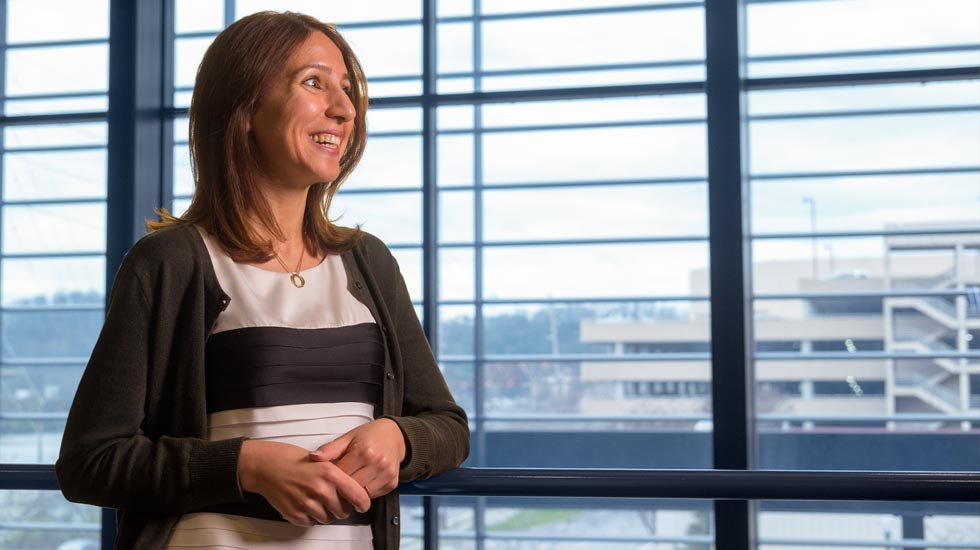The Problem Solver
By Whitney Heins. Photography by Shawn Poynter.
Pop quiz. What do sepsis patients, kidney transplants, driverless cars, and storm drainage all have in common?
Anahita Khojandi, assistant professor of industrial and systems engineering, loves being an industrial engineer because it gives her the opportunity to collaborate with a lot of different people to solve many different problems.
“I work with domain experts to understand their problems and then try to help with my tools and techniques,” she shared.
Khojandi is involved in a myriad of projects solving important problems which mostly fit into three main areas: health care analytics and medical decision-making, transportation systems, and environmental engineering.
“Each hour that goes by, the risk of death increases by 8 percent.”
—Anahita Khojandi
A major issue she’s helping medical professionals deal with is sepsis. Sepsis is a complication of an infection—and it can be deadly, especially the longer one waits to treat it.
Some existing methods can predict whether a patient may suffer from sepsis, but often present false negatives or positives. Khojandi is tapping into the historical data of hundreds of thousands of patients to find a better way.
Khojandi and her colleagues are testing an algorithm they’ve developed in hopes it will give an accurate percentage of a patient’s risk for sepsis along with how long a medical professional might have to wait to get that accurate prediction. The goal is to have this sophisticated analysis become part of early intervention protocol.
“Most algorithms stop once they make the prediction,” she said. “But we take it a step further than anyone else by looking at the practical implications of what it means to monitor a patient.”
Another problem Khojandi is working to solve has to do with the timing of kidney transplants. Get one too early and you risk losing quality of life sooner than one would have to. Wait too long, and the consequences could be dire.
Khojandi and her colleagues have developed an online tool that can estimate the ideal time to get a transplant based off information the user puts in about themselves and a potential living donor, including the patient’s glomerular filtration rate—the standard measure of the level of kidney function.
“Our tool answers the question of when is the best time to undergo this surgery taking into consideration the long- and short-term tradeoffs,” she explained. “This information is made available to physicians who can treat the patients at the optimal time, allowing for the best quality of life possible.”
The tool is available online today and Khojandi is working with an undergraduate student to develop mobile phone applications.
Yet another problem Khojandi is tackling is making our world safer when it becomes one filled with driverless cars. Driverless cars are getting better, but sensors and radars still fail to see obstacles—leading to crashes.
Khojandi is examining how the use of semi-autonomous cars may eliminate such collisions. Semi-autonomous cars allow for the vehicle to switch from being driverless to having a driver. This would become useful in various circumstances such as treacherous weather.
The challenge is that when someone is in a driverless car, chances are their focus is not on the road. So, every transfer of control can pose a risk. Khojandi and her team are developing methodologies to determine the optimal switching policy to minimize risk, considering the dynamic changes of the road/environment during the trip.
Finally, Khojandi is collaborating with other researchers at UT and ORNL on a NSF-funded project aimed at helping city planners better prepare for stormwater runoff in urban areas.
Khojandi’s work specifically focuses on developing a strategy that makes sense of conflicting climate models and combines that with information about the existing infrastructure and watershed.
“One climate model may say it’s going to be wetter in twenty years. Another says the opposite,” explained Khojandi. “So, who can they trust? We hope our work helps guide city officials on where to put green infrastructure in a watershed to mitigate flooding, water contamination, et cetera.”
Khojandi’s work touches every corner of our lives—from hospital rooms to the cars we may ride in. At UT since 2014, she’s only just getting started.
